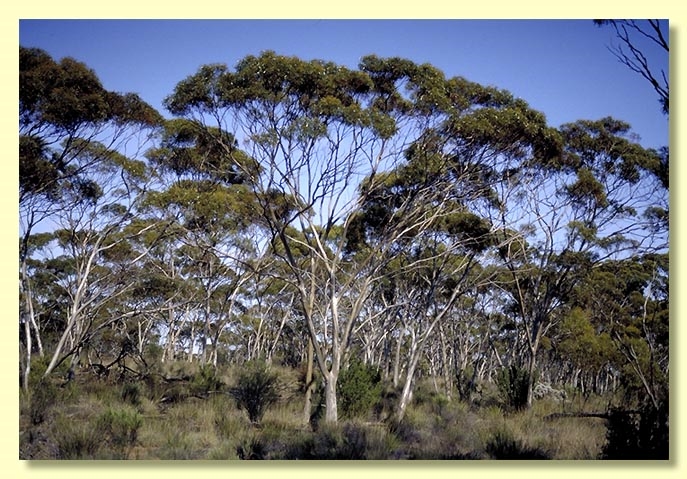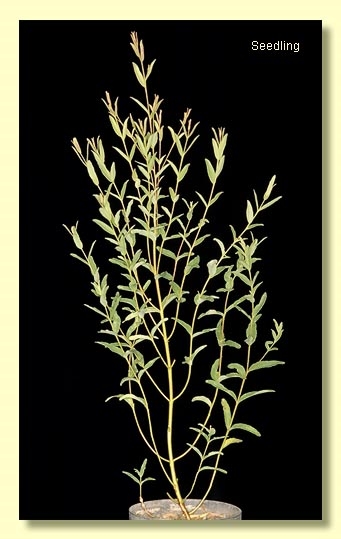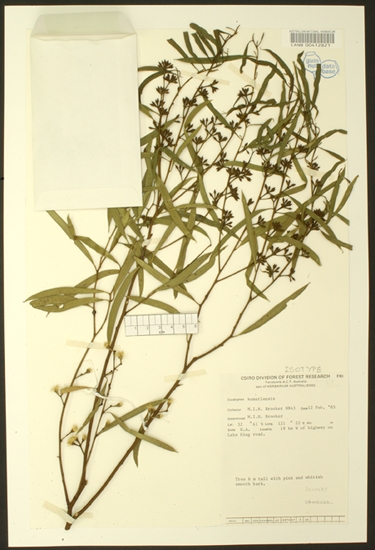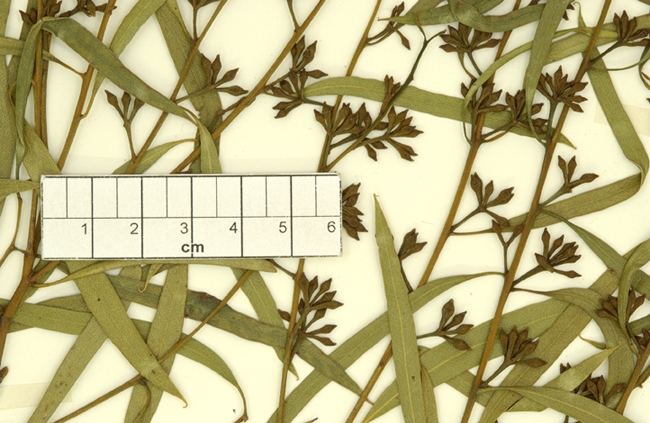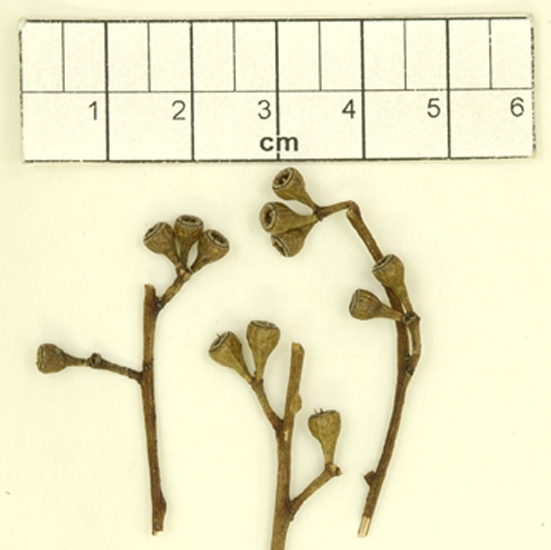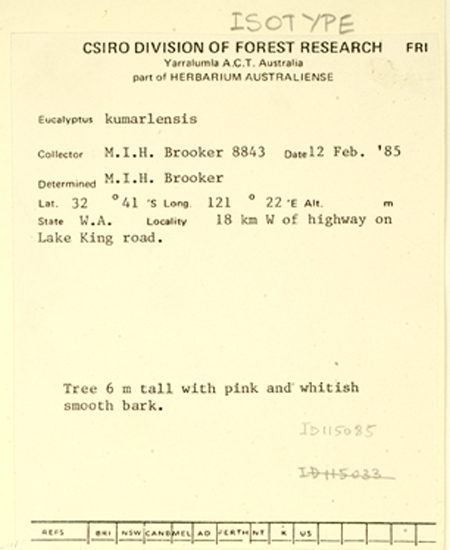Eucalyptus | Symphyomyrtus | Bisectae | Destitutae | Porantherae | Longiores
Euclid - Online edition
Eucalyptus kumarlensis
Classification
Nomenclature
Description
Tree to 10 m tall, but sometimes a mallee. Some plants seem to form a lignotuber.
Bark smooth throughout, pink to orange and white.
Branchlets lacking oil glands in the pith.
Juvenile growth (coppice or field seedlings to 50 cm): stems rounded in cross-section; juvenile leaves very shortly petiolate, lowest leaves sub-opposite soon becoming alternate, linear, 3–7.5 cm long, 0.3–0.6 cm wide, dull, grey-green until ca 0.5 m tall then glossy, green.
Adult leaves alternate, petioles 0.4–1.2 cm long; blade linear to narrowly falcate, 6–11 cm long, 0.4–1 cm wide, base tapering to petiole, margin entire, apex pointed, green, glossy, side-veins at an acute or wider angle to midrib, intramarginal vein present, moderately to densely reticulate or the reticulation obscured by the very numerous, large, intersectional oil glands.
Inflorescence axillary unbranched, peduncles narrow, only slightly flattened, 0.4–1 cm long, buds 7 or 9 per umbel, pedicellate (pedicels 0.2–0.4 cm long). Mature buds small, ovoid to diamond-shaped (0.6–0.8 cm long, 0.3–0.4 cm wide), scar present, operculum conical to beaked (0.4 cm long), stamens inflexed (rarely 1 or 2 irregularly placed), anthers cuneate-cuboid, adnate to filament apex (rigidly basifixed), dehiscing by sub-terminal pores, a few of the innermost stamens imperfectly formed, style long and straight or slightly but obviously twisted apically, stigma tapered, locules 3(4), the placentae each with 4 vertical rows of ovules. Flowers creamy white.
Fruit pedicellate (pedicels 0.1–0.3 cm long), cupular to obconical or hemispherical, 0.3–0.5 cm long, 0.4–0.5 cm wide, disc level to descending, valves 3(4), rim level to slightly exserted.
Seeds brown to grey-brown, 1–2 mm long, flattened-ovoid, dorsal surface usually furrowed longitudinally but otherwise smooth, hilum ventral.
Cultivated seedlings (measured at node 10): cotyledons Y-shaped (bisected); stems rounded in cross-section, very warty; leaves sessile throughout, opposite for 7 to 23 nodes, becoming subopposite then alternate, linear-oblong, incurved, 1.5–3 cm long, 0.3–0.8 cm wide, the margins minutely denticulate due to warts, discolorous, mid to dark green above. The seedlings are conspicuously warty.
Bark smooth throughout, pink to orange and white.
Branchlets lacking oil glands in the pith.
Juvenile growth (coppice or field seedlings to 50 cm): stems rounded in cross-section; juvenile leaves very shortly petiolate, lowest leaves sub-opposite soon becoming alternate, linear, 3–7.5 cm long, 0.3–0.6 cm wide, dull, grey-green until ca 0.5 m tall then glossy, green.
Adult leaves alternate, petioles 0.4–1.2 cm long; blade linear to narrowly falcate, 6–11 cm long, 0.4–1 cm wide, base tapering to petiole, margin entire, apex pointed, green, glossy, side-veins at an acute or wider angle to midrib, intramarginal vein present, moderately to densely reticulate or the reticulation obscured by the very numerous, large, intersectional oil glands.
Inflorescence axillary unbranched, peduncles narrow, only slightly flattened, 0.4–1 cm long, buds 7 or 9 per umbel, pedicellate (pedicels 0.2–0.4 cm long). Mature buds small, ovoid to diamond-shaped (0.6–0.8 cm long, 0.3–0.4 cm wide), scar present, operculum conical to beaked (0.4 cm long), stamens inflexed (rarely 1 or 2 irregularly placed), anthers cuneate-cuboid, adnate to filament apex (rigidly basifixed), dehiscing by sub-terminal pores, a few of the innermost stamens imperfectly formed, style long and straight or slightly but obviously twisted apically, stigma tapered, locules 3(4), the placentae each with 4 vertical rows of ovules. Flowers creamy white.
Fruit pedicellate (pedicels 0.1–0.3 cm long), cupular to obconical or hemispherical, 0.3–0.5 cm long, 0.4–0.5 cm wide, disc level to descending, valves 3(4), rim level to slightly exserted.
Seeds brown to grey-brown, 1–2 mm long, flattened-ovoid, dorsal surface usually furrowed longitudinally but otherwise smooth, hilum ventral.
Cultivated seedlings (measured at node 10): cotyledons Y-shaped (bisected); stems rounded in cross-section, very warty; leaves sessile throughout, opposite for 7 to 23 nodes, becoming subopposite then alternate, linear-oblong, incurved, 1.5–3 cm long, 0.3–0.8 cm wide, the margins minutely denticulate due to warts, discolorous, mid to dark green above. The seedlings are conspicuously warty.
Flowering Time
Flowering has been recorded in February.
Notes
Eucalyptus kumarlensis is a small tree or mallee endemic to Western Australia, restricted to a small area north of Esperance, around and west of the railway siding of Kumarl, north to Lake Dundas. It occurs on calcareous red sandy loam often with E. polita, E. eremophila, E. spreta, and E. diptera. Eucalyptus kumarlensis has smooth bark which is pink to orange and white. The adult leaves are glossy green and narrow.
Eucalyptus kumarlensis belongs in Eucalyptus subgenus Symphyomyrtus section Bisectae subsection Destitutae because the buds have two opercula, cotyledons are Y-shaped and branchlets lack oil glands in the pith. Within this subsection E. kumarlensis is one of a group of about 16 species, series Porantherae, that are further characterised by having anthers completely adnate to the staminal filaments, strongly inflexed stamens, densely reticulate leaves with intersectional oil glands and by the fruit with a distinct thick rim that includes a whitish descending disc. The small, glossy leaves of species in series Porantherae may result in confusion with species in series Heterostemones; however, the fruit alone usually distinguish the series. The fruit of series Heterostemones are thin-rimmed.
It is distinguished from other species in series Porantherae by the tree habit, coppery bark in season, conspicuously warty seedlings with linear-oblong leaves with warty-denticulate margins, linear to narrow-oblong juvenile leaves dull grey-green at first becoming green, and obconical fruit. It is probably closest to E. olivina from east of Hyden, which differs by the consistently mallee habit, greyish juvenile leaves and olive-green, slightly crenulate adult leaves. In the bark and habit E. kumarlensis can resemble the unrelated gimlet E. diptera, a species noted for its three-budded inflorescences and branchlets with copious pith glands.
Eucalyptus kumarlensis belongs in Eucalyptus subgenus Symphyomyrtus section Bisectae subsection Destitutae because the buds have two opercula, cotyledons are Y-shaped and branchlets lack oil glands in the pith. Within this subsection E. kumarlensis is one of a group of about 16 species, series Porantherae, that are further characterised by having anthers completely adnate to the staminal filaments, strongly inflexed stamens, densely reticulate leaves with intersectional oil glands and by the fruit with a distinct thick rim that includes a whitish descending disc. The small, glossy leaves of species in series Porantherae may result in confusion with species in series Heterostemones; however, the fruit alone usually distinguish the series. The fruit of series Heterostemones are thin-rimmed.
It is distinguished from other species in series Porantherae by the tree habit, coppery bark in season, conspicuously warty seedlings with linear-oblong leaves with warty-denticulate margins, linear to narrow-oblong juvenile leaves dull grey-green at first becoming green, and obconical fruit. It is probably closest to E. olivina from east of Hyden, which differs by the consistently mallee habit, greyish juvenile leaves and olive-green, slightly crenulate adult leaves. In the bark and habit E. kumarlensis can resemble the unrelated gimlet E. diptera, a species noted for its three-budded inflorescences and branchlets with copious pith glands.
Origin of Name
Eucalyptus kumarlensis: referring to the railway siding of Kumarl, south of Norseman on the Esperance line, Western Australia.
Copyright © CANBR 2020, all rights reserved.

Web edition hosted at https://apps.lucidcentral.org/euclid
